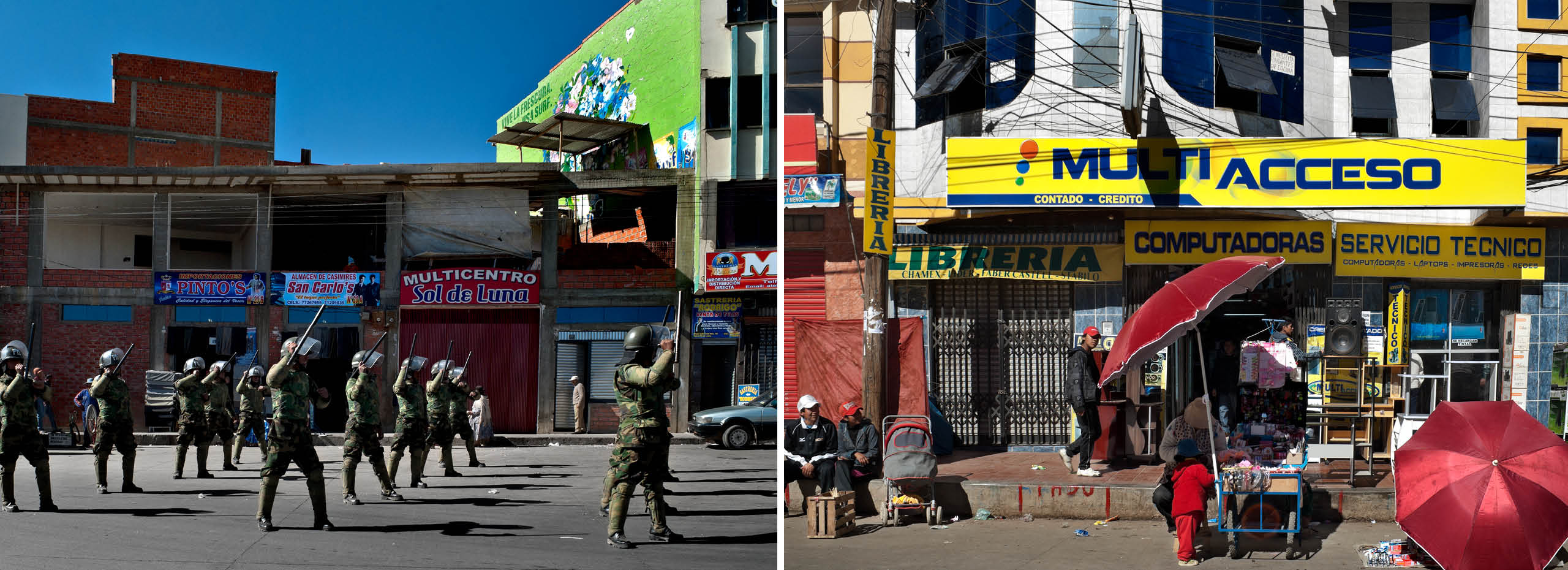
In the Gold Gallery, Floor 2L
Named one of the Top 50 Exhibitions Around the World in 2024 by Hyperallergic
In conjunction with this exhibition, the Johnson Museum hosted artist Claudia Joskowicz and a panel of curators, writers, and Cornell faculty to discuss topics related to her video works: click here to watch.
Every Building on Avenida Alfonso Ugarte—After Ruscha, a two-channel video installation by Claudia Joskowicz, opens with a view of daily life along Avenida Alfonso Ugarte in El Alto, Bolivia. Two slow-motion tracking shots, a signature of Joskowicz’s video work, reveal both sides of this commercial thoroughfare in single takes, each twenty-six minutes long: crowded storefronts, pedestrians, painted buildings, street vendors, trotting dogs, clear blue sky. People wave to the camera. The slow pan, languid movements, and ambient noise have a lulling effect; the spectacle of the street is dreamlike. Then, a moment of violence: in the middle of the street, standing in tableau, a formation of soldiers in riot gear face civilian men, women, and children carrying Bolivian flags and little to protect themselves. They hold their positions as the camera moves past them down the avenue.
Located less than ten miles from La Paz, El Alto is the country’s next-largest city. Its population is principally Indigenous: Aymara and Quechua. In October 2003, at the height of the national conflict over the exploitation of Bolivia’s natural gas reserves, it was the site of citizen protests and a brutal military response that killed nearly sixty people and wounded four hundred others. From this uprising emerged Bolivia’s first Indigenous president, Evo Morales. By inserting the tableau that references this event into scenes of everyday life in El Alto, Joskowicz explores how cataclysmic historical incidents continue to reverberate in physical space and all other facets of present reality, and points toward protest and violence as constant possibilities in Bolivian society.
The title of the video references Ed Ruscha’s photobook Every Building on the Sunset Strip (1966), a seminal work of conceptual art for which Rushcha systematically photographed a one-and-a-half-mile stretch of Los Angeles’s famous Sunset Boulevard. The contexts and techniques of the two artists’ works are dissimilar, but each probes the function and limitations of the documentary mode. What truths can a visual inventory ultimately disclose?
This exhibition was organized by Kate Addleman-Frankel, the Gary and Ellen Davis Curator of Photography, and supported by the Joel and Joan Picket Exhibition Endowment and the Mary Hyde Field Endowment.
Claudia Joskowicz, born 1968 in Bolivia; lives and works in Bolivia and the United States. Every Building on Avenida Alfonso Ugarte—After Ruscha, 2011. Two-channel digital HD video installation (color, sound); 26 minutes. Edition 2/3 + 2 APs. Courtesy of the artist and Jorge López Galería, Valencia, Spain.








